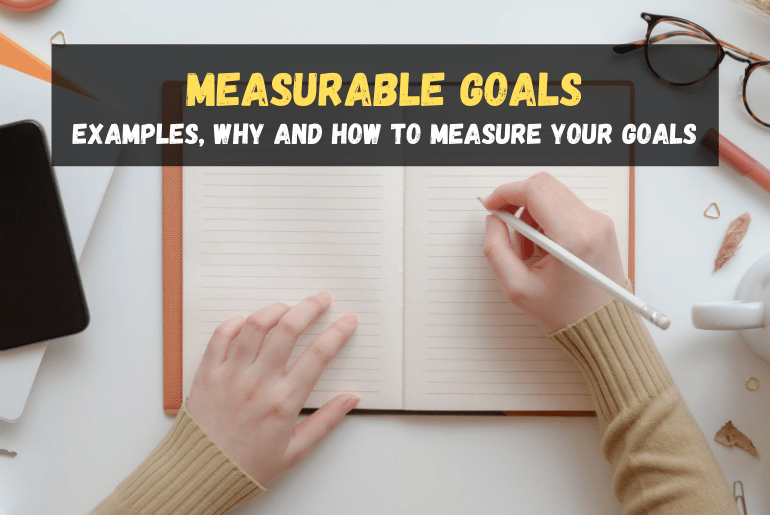One of the main reasons why you want to make your goals measurable is that when you can measure them, you can tell if you are making progress. As the legendary management consultant Peter Drucker once said, “If you can’t measure it, you can’t improve it.”
Most people understand the importance of having a goal, but the majority of them don’t write down their goals. They only keep their goals in their head.
Plus, even if they write down their goals, they have no idea how to make their goals measurable. This is why according to the University of Scranton, only about 8% of people who set New Year’s goals successfully stick to their goals and reach their goals.
What about the other 92% of people? Well, they fail and give up halfway.
I bet you don’t want to fall in the 92% category, eh?
When we set goals, we want to make sure we can reach our goals. If we’re not going to achieve our goals or follow our plans, there is no reason for us to set goals in the first place.
And to achieve the results you want, to accomplish your goals, you must make sure the goals that you set are what you truly want to achieve. More important, you want to ensure your goals are measurable.
When your goals are measurable, you can tell if you are moving forward or away from your desired results.
Why Your Goals Need to Be Measurable
Imagine if your goal is to lose weight and get back in shape. So, what is the first thing that you need to do?
You stand on the weighing machine and measure your weight.
That’s the first thing you need to do – you measure where you are right now.
Just like using a GPS to get to your destination. For the GPS to work, the system needs to know 2 things: Where you are, and where you want to go.
If the GPS doesn’t know where you are, it can’t help you to get there. Similarly, if the system doesn’t know where your destination is, it can’t calculate and measure to give you a direction.
This is why you want to measure your goals. If you don’t measure them, you will never know if you are making progress or stagnant. You can never tell if what you do is getting you closer to your goals or not.
Below are a couple of reasons why you need to make your goals measurable…
1. It tells you where you are.
When you know where you are, you can come up with a better plan to get to where you want to go. For instance, if you want to be a champion in golf, you need to know your skills, your strengths, and your weaknesses. When you know about yourself, your coach can then come up with an effective training program crafted specifically for you.
2. You can improve where you can measure.
Peter Drucker said, “What’s get measured, gets managed.” You can’t improve something you can’t measure. When you put up an advertisement on Facebook to promote your product, you want to know if your ad copy is getting the clicks. If you can’t measure it, you can never tell if your ad is bringing in the results that you want.
The same goes for every goal that you set. You want to make them measurable if possible and find a way to measure your progress.
3. It allows you to pivot through immediate feedback
In business, there is a concept called Minimum Viable Product or MVP. It means creating a product with just enough features to be usable by early customers who can then provide feedback for future product development.
And when you set a goal, especially big goals that are out of your current capability to achieve, you need to measure your goals so that it gives you immediate feedback for improvement.
Like how the MVP works, you pivot using feedback and improve to achieve better success. But this only works when you measure your goals. If your goals are not measurable, you can’t tell if things are working.
5 Great Tips How to Measure Your Goals
Now that you understand the objective of making your goals measurable, it is time to learn to apply the principle to your goals – measure your goals.
The issue with a measurable goal is that some of our goals are simply not measurable. Like if my goal is to build an intimate relationship with my wife, how do I measure that?
Well, there will be no direct numbers to measure, but still, I can somehow make it measurable such as creating a list of things I can do together with my wife that will build up our relationship.
And as I cross-check the list, I’m making progress toward my goal of getting in love with my wife again.
So, here are 5 tips you should follow and implement when it comes to measuring your goals…
1. Make your goals quantifiable
Try to make your goals as quantifiable as possible. Use a number. For example, if you want to lose weight, identify your current weight and the ideal weight you want to achieve.
- If you weigh 70kg now, your goal may be to get to 65kg in 3 months.
- If your goal is to write a book, you can make it measurable by including the # of pages, # of chapters, and then measure your progress to see how many words or chapters you have completed.
- If your goal is to save a portion of your income, make it quantifiable by including a specific number. Such as you can save 10% of your monthly income or save $500 every month.
When your goals are measurable, the easier it is you can execute and work on the goals. Why? The reason is simple. When your goals are specific and measurable, you are giving your mind a clear instruction of what to do.
Hence, you are more likely to follow through and stick to your plan.
Read: Specific Goal Setting: How to Set Crystal Clear Goals
2. Include a start point and an endpoint
One of the easiest ways to state your goal is to have a start point and an endpoint. Here’s how you can do it:
To achieve [goal] from X to Y by Z
Just write down your goals according to the above formula. Here are a few examples…
- To increase sales from $500,000 to $700,000 by end of January 2021.
- To make 100 cold calls to potential clients before 5 PM today.
- To write a 2,000 words article and publish it by Tuesday.
The above are just some examples. When you use the “from X to Y by Z” formula to set your goals, you are making your goal quantifiable and you can measure your progress.
Read: How to Measure Your Progress to Effectively Achieve Your Goals
3. Create a scoreboard to measure your progress
Next, make good use of a scoreboard. Do you have a scoreboard to measure your progress for your goals? If you don’t, it is time to create one right now.
When you display a scoreboard, like the one hanging in the center of a basketball court, you allow yourself to know your progress.
At a glance at the scoreboard, you can tell if you are winning, losing, how much time left, and how far you are from your goal.
It is a great way to motivate yourself to take action. In one of my blog posts, I shared why having a scoreboard is important:
Just imagine that when you take a walk in the park and you can see a group of kids playing basketball from afar. You can see their moves but it is too far away for you to hear them. Instantly, you can judge it from afar whether they are playing for fun or they are competing and keeping score. Why is that so?
This is mainly because when they play for fun, they are not going to be serious. However, if they keep score, it means competition and they will play seriously. Can you imagine what would happen if people go for the World Cup without keeping the score? Regardless of which team makes a goal and it does not count? It will be a complete waste of time. No one would want to watch the match.
I suggest you read the blog post: Keeping Score: The #1 Reason People Fail To Achieve Their Goals
The same principle applies to all your goals. The moment you lose track of your goals, you will lose track of your progress and focus. You will then be distracted by other things and eventually lose interest in your goals. And finally, you will give up.
This is why you want to measure your goals. Not just to keep yourself motivated, but at the same time, knowing your progress keeps you focus on where you want to go.
Read: How to Track Your Goals: 5 Fabulous Ways You Should Consider
4. Set your goals using the SMARTER goals framework
If you want to make your goals measurable, stick to the SMARTER goal setting framework.
You might have heard about the older version of SMART goals, but SMART goals may not be the best way to set your goals. This is because the SMART framework lacks 2 other factors: Excitement and Risky.
The acronym for SMARTER goal setting is…
- S – Specific
- M – Measurable
- A – Actionable
- R – Relevant
- T – Time-bound
- E – Exciting
- R – Risky
You want your goals to be exciting so that you feel motivated when you think about achieving them. At the same time, you want your goals to be a little risky so that they challenge you to move out of your comfort zone.
I strongly suggest you read my guide for the full explanation below:
How to Set SMARTER Goals and Achieve Them
Conclusion
Goal setting is a powerful tool that anyone can use to help them achieve what they want in life. The problem is that most people have no idea how to set the right goals and how to set them the correct way.
When you do it right, your goals will drive you and empower you in life. But when you do it wrong, your goals may seem like a daunting task and you’d wish you didn’t set them in the first place.
This is why I created Goal Setting Formula Masterclass. In the program, you will learn how to set the right goals, make them exciting, and empower you.


